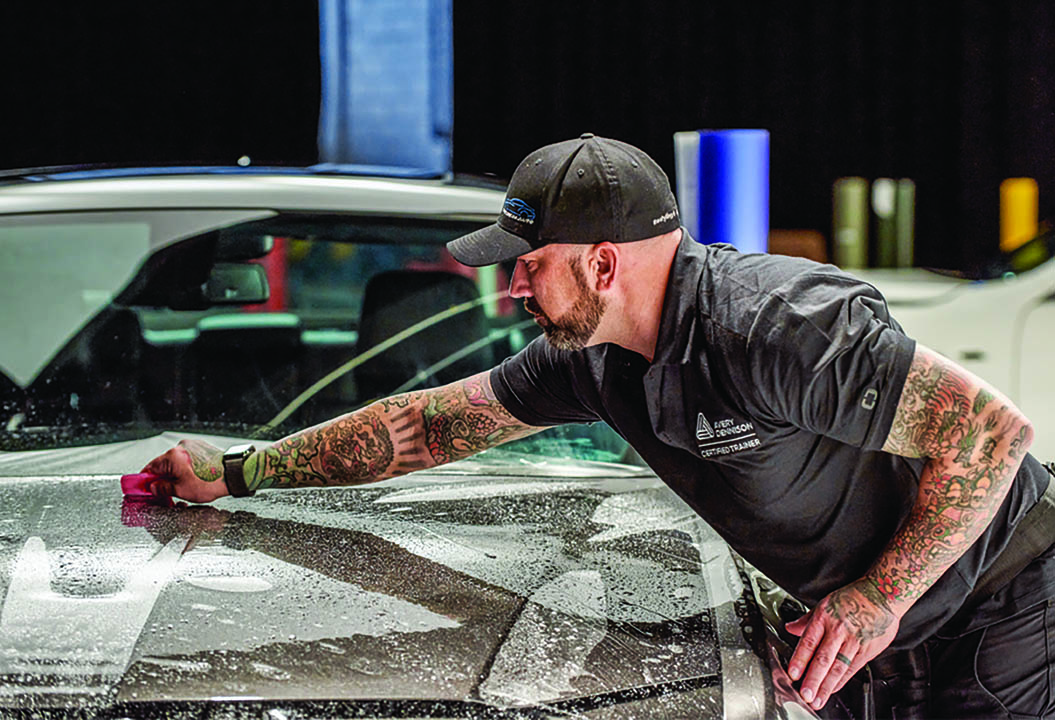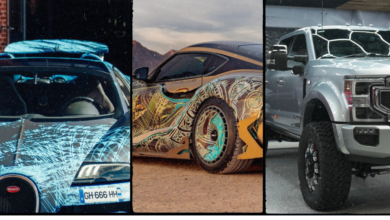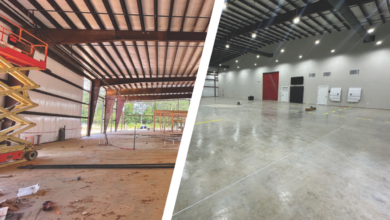The graphics industry continues to evolve tremendously in both size and scope. Today, professional opportunities extend far beyond traditional offerings like custom goods or personalized items to include niches such as paint protection film (PPF) — a thermoplastic polyurethane-based material designed to protect a variety of surfaces from gravel, scuffs, abrasion, contamination, UV fading, and more.
From wartime roots to a NASCAR debut, modern PPF is not only commonly installed on vehicles, but also RVs, tractors, trailers, boats, and other high-end assets like mountain bikes, UTVs, and even electronics.
In addition to its unique construction, both the adhesive and application process also distinguish PPF from traditional vinyl wrap materials, explained Michael Honn, director of marketing at STEK USA. For example, since PPF utilizes a pressure-sensitive adhesive (PSA) instead of an air channel, the product must be installed wet using a slip-and-tack mixture that is then squeegeed out.
Overall, Honn says PPF is more durable against surface damage, lasts longer, and offers a higher-quality finish compared to standard vinyl.
“[Moreover,] PPF can enhance the surface beneath it, making it look freshly polished or ceramic coated, bringing out a smoother aesthetic and richer colors without having to complete the polishing and coating steps,” he noted.
As such, the versatile product is “a rapidly-growing addition” at many businesses, from automotive restyling and detailing to commercial branding and graphic shops, added Marc Bagley, segment marketing manager in the personal auto and commercial branding and transportation division at 3M.
“Since you are selling protection, there will always be someone in the market seeking that peace of mind — even during uncertain economic times,” he continued.
With consumer and commercial demand on the rise, many business owners are intrigued by its attractive value proposition. Expanding into PPF may be tempting and, admittedly, profitable; however, such diversification should be well planned and executed, cautioned Mike Montemurro, owner of Atlantic Pinstriping & Vehicle Wraps — a top-tier wrap shop with five franchise locations servicing Charlotte, North Carolina, and surrounding areas.
As a specialist in hand-drawn pinstriping and lettering services, plus a nationally-recognized wrap and PPF installer, Montemurro stresses the importance of investing in a proper shop setup, partnering with high-quality brands, and completing professional training before pressing forward.
Proceed with a prudent amount of caution, he advised, and hone the necessary skills before accepting a new customer base with sky-high expectations.
“Our customers, [whether they drive a Lamborghini, Lexus sport coupe, or Tacoma], can pick a different color of grain out of the sand from 50 feet away. They know exactly what they want and if something isn’t just right, it shows,” Montemurro said, emphasizing the importance of building and maintaining a solid reputation in PPF installation.
While he believes offering a superior product is undeniably important, “ultimately, it always comes back to the [quality of the] install.”
“It’s important to note that PPF is a self-sacrificial layer and not bulletproof. So, if a surface protected in PPF undergoes a lot of wear from, say, a track day or off-roading, the wear will show over time,” Honn added, noting installers must be skillful at applying, repairing, and replacing PPF.
Industry pros agree that PPF application is a delicate balance of art and science mastered through years of hands-on experience. Fellow experts David Korvah, marketing manager at Avery Dennison Graphics Solutions, and Javier Cruz Rivas, a HEXIS certified installer at Mad Monkey Wrapz in Vineland, New Jersey, join the discussion with Honn, Bagley, and Montemurro. Together, they lend valuable market insight, highlight new innovations, and discuss key category predictions.

Paint protection film: A clear choice
First introduced by 3M during the Vietnam War to protect helicopter blades, paint protection film later proved useful in NASCAR as a way to shield sponsor graphics from damage and avoid splintered plastic parts in the event of collisions. Before long, consumers were intrigued and opportunity came knocking for retailers, detailers, and wrap shops across the country.
“In the beginning, it was like trying to put a cardboard box on a car,” Montemurro said. “The software patterns were lacking, film was so thick you couldn’t wrap the edges, oftentimes the product yellowed in one to two years, and the orange peel was terrible.”
“But it did stop rock chips,” he noted.
Javier Cruz Rivas, a professional installer at Mad Monkey Wrapz in Vineland, New Jersey, agrees the original product was inferior, previously prone to degradation from UV rays, rain, and road debris, while often becoming discolored or cracking — and disappointing customers in the process.
Fast forward and next-generation PPF is taking the industry by storm, featuring expanded offerings, upgraded product quality, enhanced shine and finish, as well as greater longevity and ease of installation.
Rivas points to the category’s enhanced durability, clarity, and protection against environmental damage.
“Over the years, I have worked with several PPF brands and prioritize two key factors: quality and product properties,” he said.
In addition to durability and clarity, Montemurro says manufacturers immensely improved the adhesive, discoloration, orange peel, and “workability of the film,” resulting in a superior product and easier application.
“These are qualities I look for in a company,” Montemurro stated. “I also want to know if they manufacture their own film and if they are a private or publicly-held company.”
“A private company is accountable to installers and end users alike. No matter the industry, when you’re publicly held, you’re beholden to shareholders,” he continued.
As such, the owner refrained from jumping into the category until there was a brand and product selection he could stand behind.
“When you’re in business, it’s not just about completing a job, getting paid, and rushing a customer out the door. That client has to look at the car for years and years to come, so we need to make sure that what we do meets those expectations and they have no problems with it [the product and installation].”
Game changer

Today, paint protection film constitutes approximately 30% of business at Atlantic Pinstriping & Vehicle Wraps. Montemurro calls attention to color and pattern-change options.
Traditionally, paint protection film was available as a transparent gloss or matte finish, until fashion films became available. Honn and Montemurro agree the addition of color and pattern gives clients an option to customize their vehicle with a film that, oftentimes, dons as high quality of a finish as a high-end paint job. Featuring an industry average 10-year lifespan, plus the same self-healing, anti-contaminate top coat as clear PPFs, this option can easily outlast a vinyl wrap, which may tire in aesthetics after two to four years.
“The benefit of using PPF as the color change is that you can always remove it to get back to the factory finish, which should still be in pristine condition (if installed correctly), thereby increasing resale value,” Honn said.
Honn credits company innovators for pushing boundaries in new technology, resulting in “some of the most realistic-looking carbon fibers and forged carbon automotive films on the market.”





